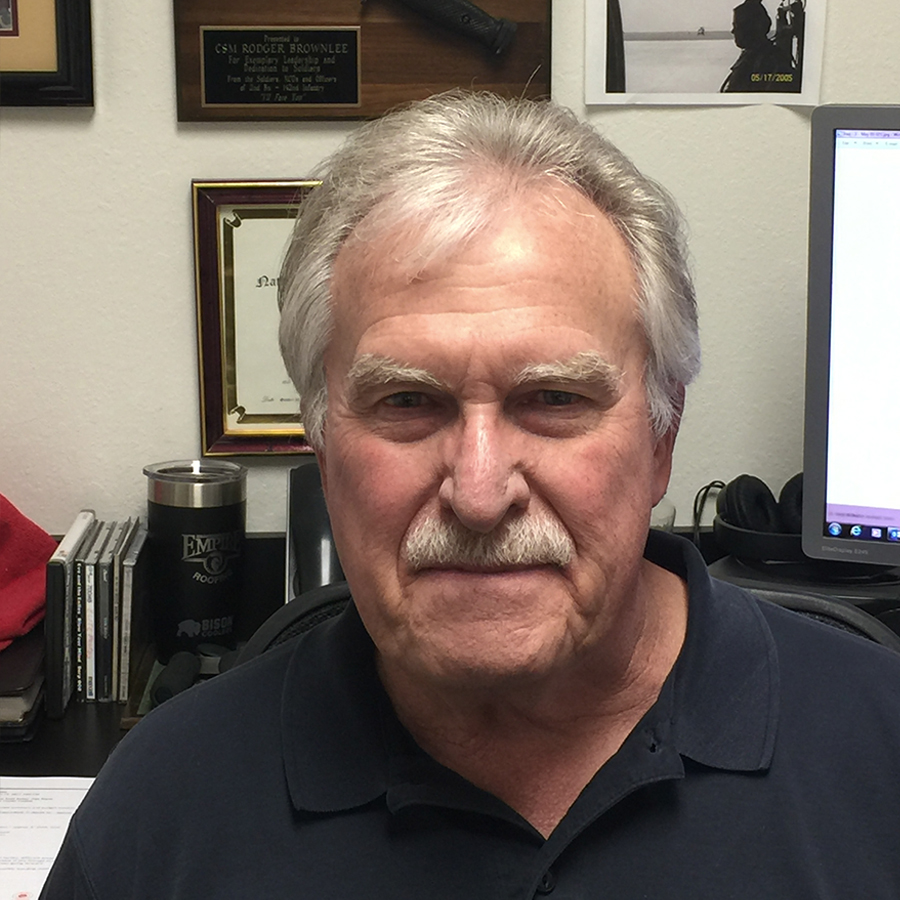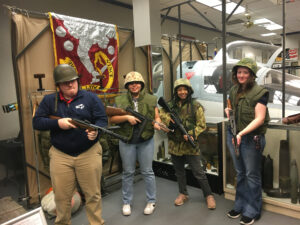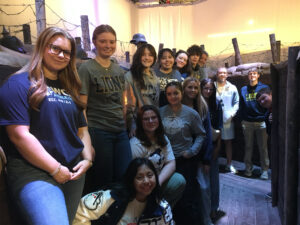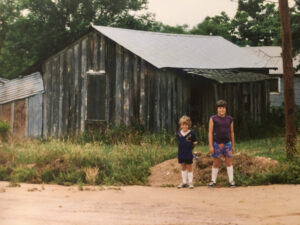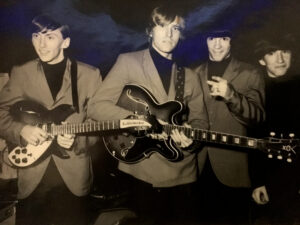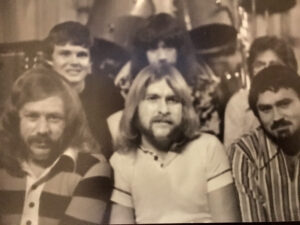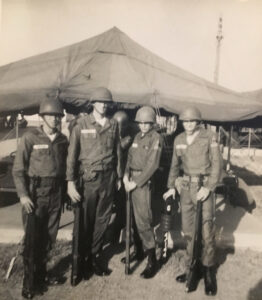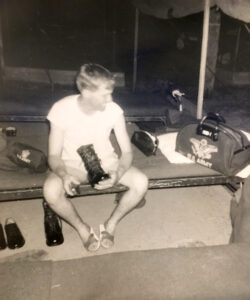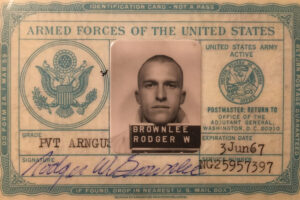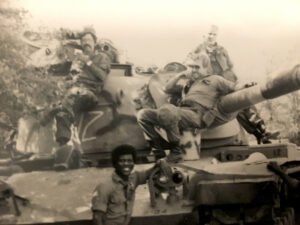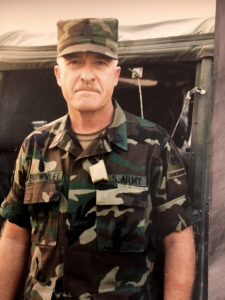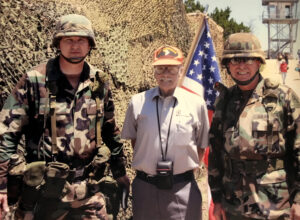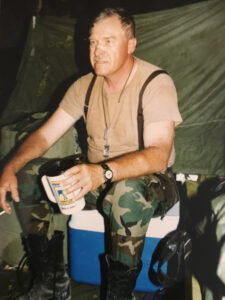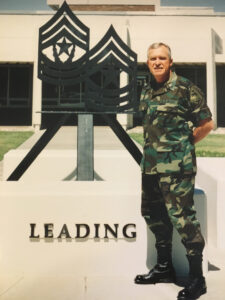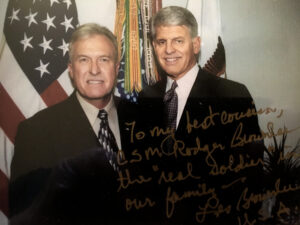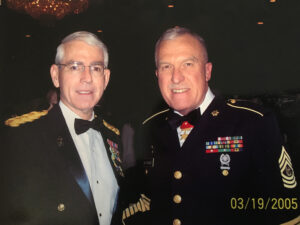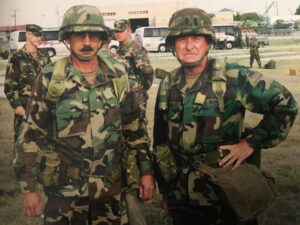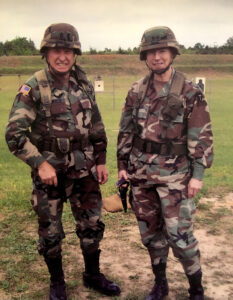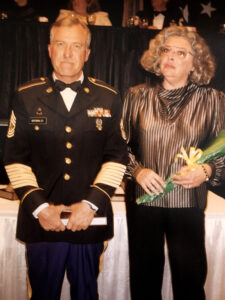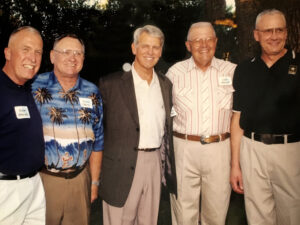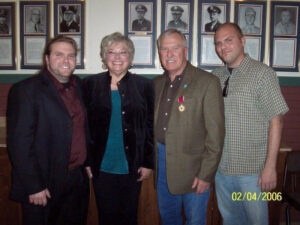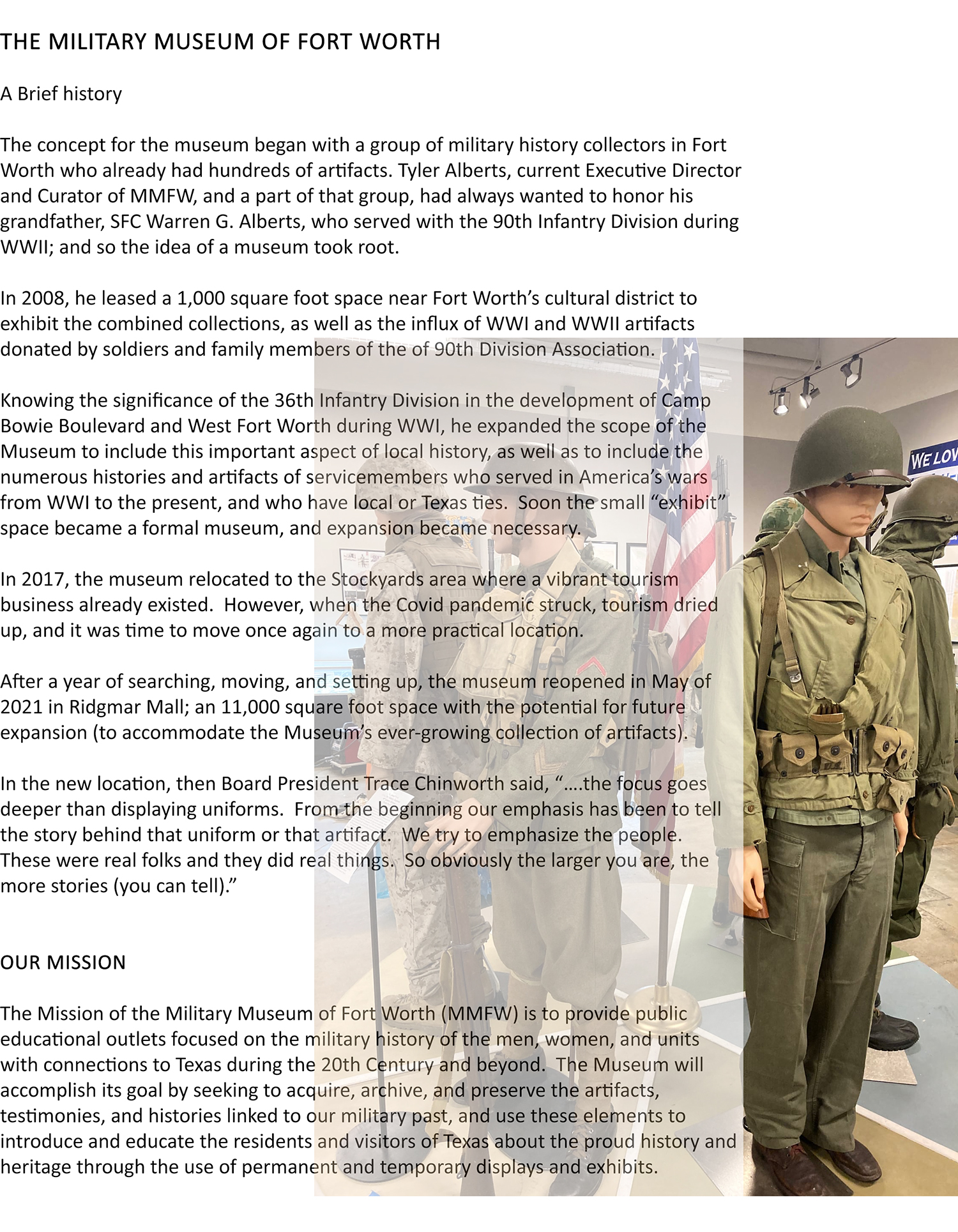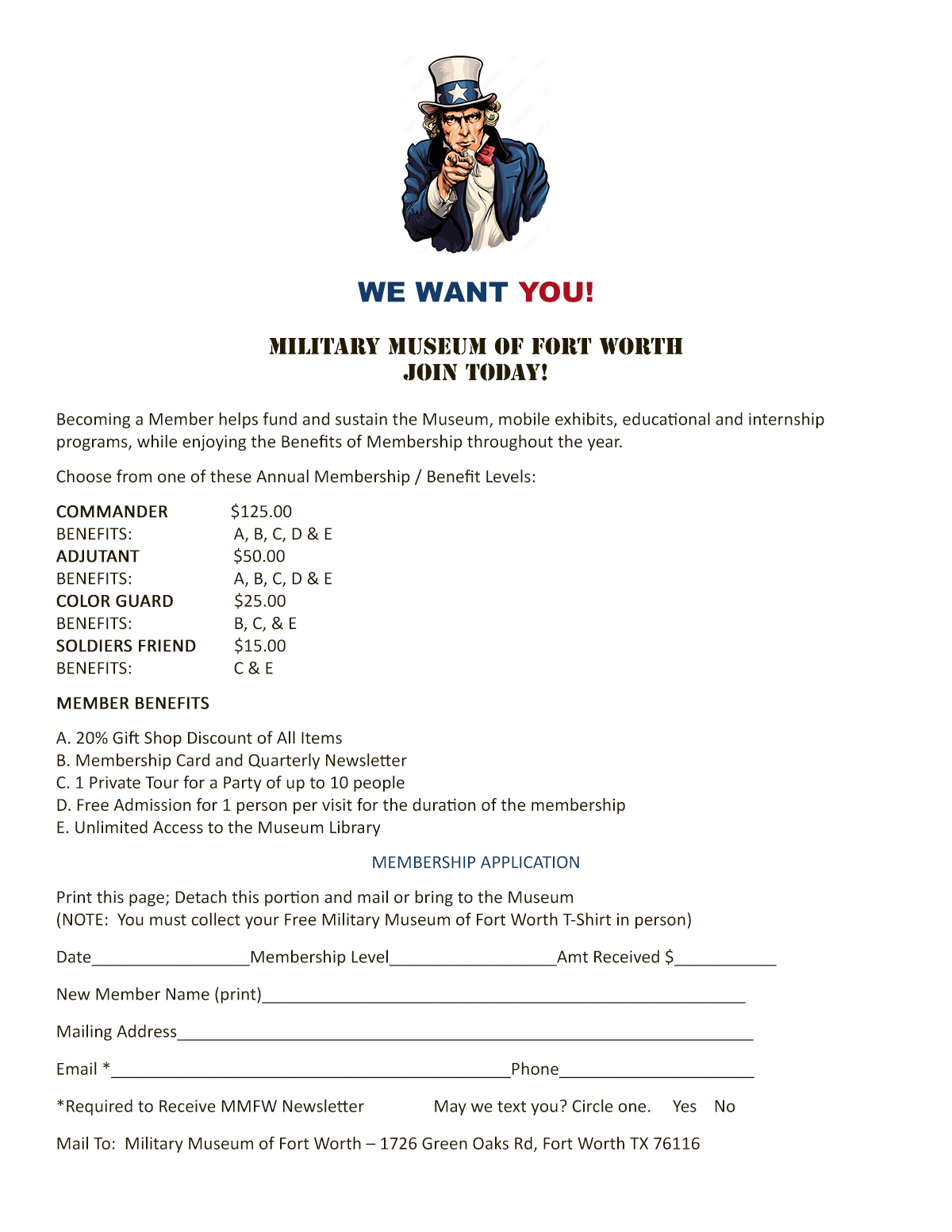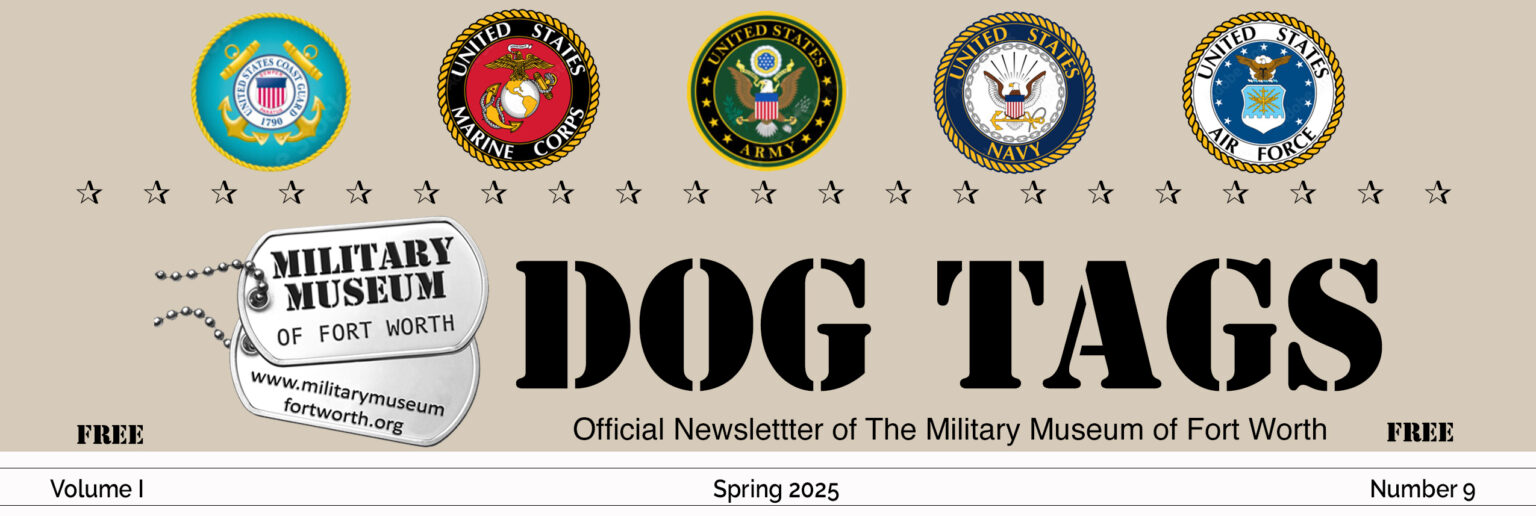
SIT REP (Situation Report)
Rodger W Brownlee
The never-ending cycle of the seasons has come full circle once again treating us to the beauty of mother nature, as her plants and creatures bring forth new life and beauty. The Winter was relatively mild and dry, nonetheless, (foregoing waxing poetic any further), the changing of the seasons also means that we can trade layers of cumbersome clothing for shorts, T-shirts, and flip flops; and can go out and enjoy the wonders of Mother Nature to its fullest.
There's also something about Spring that renews the spirit and energizes expectations, and that's the feeling currently flowing through Military Museum of Fort Worth. We have some exciting prospects that may allow the Museum to overcome her existing circumstances and become bigger and better than ever. So, keep our fingers crossed, and say a little prayer that these prospects will come to fruition.
The flow of visitors, as previously reported, has been slow, but occasionally there are bright spots that make it all worthwhile. For example, in February, the Museum was visited by a pride of "Lions" from Weatherford Christian School. Thirteen Seniors and two of their teachers immersed themselves for over two hours in the history spread out before them. They seemed to especially enjoy the interactive, hands-on aspect of our displays and exhibits (see attached photos). They were a bright, inquisitive group who fully appreciated the total experience. MMFW welcomes all school groups, especially those as enthusiastic as the WCS Lions; we hope they come back to see us again soon.
The restoration of the armored component of MMFW is proceeding apace. Just a few days ago, we received a video (complete with sound) of our M3 Stuart tank* firing up for the first time in years.
SIT REP CONT.
The smoke and the rumble of this WWII era veteran clearing its throat was music to the ears, (you can see the video on our website and Facebook page). We hope to see it in motion in the not-too-distant future.
Our White half-track* is also being lovingly restored and getting closer to operational status thanks to a generous donation that allowed us to finalize the purchase of its new engine. Along with the new engine and new wiring harness, it's only a matter of time before the 1/2 punch of MMFW's armor will be ready for action.
As emphasized in my last SITuation REPort, finances are still a top priority for the Museum, so Donations, as well as Volunteers and new Members are still needed and always welcome.
Out Here
* "Our" M3 Stuart and White half-track are the property of MMFW Board Member, Ron Lane, who has generously put them on indefinite loan in partnership with the Museum.
| Tyler Alberts | Co-Founder/Executive Director |
| Rodger W Brownlee | President/Newsletter Editor |
| John Kalvelege | Vice-President Director |
| Karen Garrison | Media and Communications Director |
| Trace Chinworth | Director |
| John T. Furlow | Treasurer |
| Mike Zamulinski | Director |
| Bill Leaf | Special Projects/Board Member |
| Ron Lane | Board Member |
| Stacey Sokulsky | Board Member |
| Dale Wagner | Board Member |
| James Warner | Board Member |
| VOLUNTEERS | |
| Randie Debnar | Volunteer |
| Colin Fish | Volunteer |
| Donna Kelly | Volunteer |
Board Member Spotlight
CSM Rodger W Brownlee – r
BY: Himself
I was born 28 December, 1945 at the Blackwell Sanitorium in Gorman, Texas, to James Weldon Brownlee and Viola Kathryn (Meek) Brownlee. They were living at the time with my grandfather, Romer Brownlee, in a small one room house on the edge of De Leon, Texas.
My father had been drafted in 1942, but failed his medical exam due to hypertension, a condition attributed to the fact that before the war, he handled Liquid Nitroglycerin in the oilfields. Failing his medical, and because he had a background with explosives, it was decided he would do his bit for the war effort by building bombs. After attending ordnance school in Ravenna, Ohio, he moved with my Mom to Papma, Texas and worked for Pantex, producing heavy ordnance for the military. It was there on January 10, 1943, that my older sister, Belle Kathryn, was born.
When the war ended, and wartime production wound down, Dad returned with his family to his hometown, DeLeon, Texas, moving into his father's tiny one-room house. Our family occupied a small, 10’ x 12’ enclosed back porch as their bedroom. My sister says it was pretty crowded and very cold during the Winter, so they all slept together in a single bed with a goose feather mattress. Modern amenities were sparse, with only a single bare lightbulb in the house, and one cold water tap in the kitchen. Going to the bathroom was an adventure; a hike through a sunflower patch to the outhouse next to the chicken coop out back.
When I was born, my Dad drove my Mom in the middle of the night to Gorman, Texas, 12 miles distance. I came into this world in Blackwell Sanitorium, delivered by Doctor David V Rodgers. My mother liked the name so well, I became Rodger Weldon. Rodger after the doctor, and Weldon after my father's middle name (the "d" in my first name has been a source of confusion and consternation ever since).
After living in De Leon for a couple of years, my father returned to his pre-war job of "shooting" oil wells, which meant our family would be moving around for the next few years.
We first resided in Colorado City, Texas most notable as I remember for its jackrabbits, sand, and grass burrs; then to Odessa, Texas with its forests of oil derricks all over town; Aztec, New Mexico where I started first grade at age 5 in a depression era school building with Navajo Indians as my classmates; Eagle Mountain Lake in N Tarrant Co. Texas where I attended first through fifth grades; and finally Newark, Texas in Wise Co., where we lived when my High School graduation rolled around. Some notable aspects of these travels are that when we lived in Odessa, I became well acquainted and lifelong friends with my first cousin, Les Brownlee, with whom I shared a love for the military; and then when we lived at Eagle Mountain Lake, I got to know my Uncle, E.C. Meek, who shared his stories of service in WWII. Both these figures became two of my personal heroes and had a significant influence on my future plans of becoming a soldier.
While living in Newark, 1964 proved to be a pivotal year for me in many ways. I already had the rest of my life planned out, or so I thought; I would graduate from high school that Spring and attend UT Austin that Fall; I had already applied and been accepted to the School of Fine Arts. I would also take ROTC and get a commission in the Army as my cousin Les had done, and who, by this time, was already an officer in the Paratroops. Fate, however, has a way of wrecking the best laid plans.
During my Senior year, my father was diagnosed with cancer and passed away later that year, right before Christmas. My older sister was overseas with her soldier husband, so it was up to me to help take care of my Mom who was not well, and my younger sister, Shela. My future plans vis a vis college and ROTC were put on hold indefinitely, and would eventually go out the window altogether.
Taking a construction job, it was during this time that I fulfilled another of my lifelong ambitions, starting and being a member of a rock band. Beatlemania was in full swing, and I was a "Beatlemaniac". I connected with some like-minded guys, and that set me on a parallel career course that would last for the next 11 years.
Helping take care of my Mom and younger sister became further complicated when I received my Draft notice. An application by my Mom for a hardship deferment was turned down, so I weighed my options; I had only two left, get drafted or join the Reserves. A family friend and neighbor, Al Houser, was a Staff Sergeant in the Army National Guard, and had been after all the local boys to join up after graduating high school.
On 29 October, 1965 I made my way to the Lake Shore Drive National Guard Armory in White Settlement, took my entrance exam, and was sworn in to the Texas Army National Guard, as a member of HQ & Co A, 949 Maint. Bn, 49thy Armored Division. I scored a perfect 100 on my entry exam, so the AST put me down as an OCS candidate. That was great with me; that covered the college ROTC aspirations I was going to miss. All this done, I was set on another career path that was to last for the next four decades, ending on 31 December 2005.
Starting out, my first armory drills took place in the evenings one night a week. There were about forty of us, so an NCO was assigned to teach us "Drill and Ceremonies", how to stand at attention, march, do facing movements and so on. We were soon issued uniforms and equipment; decked out in cotton ODs (with white name tapes and black and yellow US Army patches), we began feeling like real soldiers, and even more so when we wore our WWII era web gear and steel pots (we were all "buck privates", so wore no rank insignia). The crowning touch was when we were issued our M1 Garand rifles. We felt like the proverbial WWII G.I. Joe; the real deal and couldn't wait to get pictures made.
During this time, there was such a huge influx of new Guardsmen, that we were put into a newly established state program that would ostensibly serve as our "basic training". For the next few months, we drilled at the Cobb Park armory, where our training cadre was made up of "tankers", members of 2/112th Armor Battalion. They were very strict and ran us through the mill; more drill and ceremonies, hand to hand combat, and PMI (preliminary marksmanship instruction) among the myriads of subjects they taught us. It was sort of a "basic training" preparatory course that continued right up to the month of June, when Summer Camp (Annual Training or AT) rolled around. During the two weeks of Summer Camp, we continued our Basic training, doing everything usually covered in 8 weeks of active duty basic compressed into a two-week period. It was a grueling training routine 24/7, culminating in weapons qualification with our fabled M1 Garand rifles, with which I qualified as a "Marksman" (and left my shoulder bruised and sore for weeks). It was also a sobering introduction to Fort Hood Texas, with its 100 plus degree summer days, and its rocky, dusty, cedar covered, caliche terrain. I would get to know this terrain intimately over the next several years.
We thought we were done, would return to our home stations, be assigned a Military Occupational Specialty (MOS), and would go on with our Guard careers. I began signing up for correspondence courses, while at the same time patiently awaiting the status of my OCS application. All during this time, I was playing music with my band in between drills.
With the ramping up of the VietNam war, the Department of Defense (DOD) decided that all reserve component soldiers with less than two years’ service needed to attend active duty basic training and AIT; so in January of 1967 I found myself being processed at Ft. Polk, LA, before shipping to Ft Jackson, SC., where I received eight weeks of basic training in a 250 man company comprised of volunteers (RA), draftees (US), reservists (ER), and national guard (NG) soldiers. All training focused on the war in VietNam and It was tough, but the individual training segments were actually easier than those I had done at Ft. Hood less than a year before.
At the end of our eight weeks, we were given our orders and put on busses headed for our new destinations for Advanced Individual Training, or AIT. I was surprised and somewhat dismayed to learn that instead of heading for Ft. Lee, VA for a maintenance administration course, I was being sent to Aberdeen Proving Grounds (APG), Maryland to attend the U.S. Army Ordnance Center and School to become a "Recovery Specialist", or in the more popular jargon of the school, a "mud diver". APG was located on the edge of Chesapeake Bay and surrounded by the swamps which would be our training areas. We were issued cold and wet weather gear, and soon learned why the nickname, "mud diver"; we sometimes waded through chest deep water and mud to get to the vehicle or equipment we were required to recover. Our training was conducted at night, under floodlights, and it was always cold, wet, and muddy. As it turned out, I excelled at "mud diving” and finished as the "Honor Graduate" for my class. I was awarded the MOS, 63Foxtrot20.
Returning home, we fell into the boring routine of weekend drills at the armory, and Summer Camps at Fort Hood. I had been promoted to Specialist 4th Class upon my return from AIT, and as I entered the sixth and final year of my enlistment, I was promoted to Specialist 5th Class.
My ETS on 28 October 1971 was uneventful. All of my group, some 30 to 40 people, showed up to our last drill in civilian clothes, since we were turning in our military gear. The highlight of this day was an officer addressing our group telling us how valuable we were, attempting to entice us to reenlist. A handful of the men did, but the rest of us vowed we would never suit up again. We dismissed ourselves to the local bar and drank toasts, over and over, congratulating ourselves that we had lasted the six years. (BTW, I was stonewalled about my OCS application to the point that I finally forgot all about it. (In light of future events, I'm glad it never happened).
I had continued playing music all this time, so after the Guard, I threw myself into this pursuit full time. I finally wound up fronting a band of real pros plying the nightclub circuit in N Texas. It was a fun, interesting time in my life.
In 1975, I met and married the love of my life (married 49 years as of this writing), Nancy Claire Smith, a Poly girl. Not only is she beautiful, but also the smartest person I've ever known. Together, we produced two wonderful sons, James Hudson in 1977, and Andrew Hale in 1980.
Around this time, at the urging of my best Army buddy, I signed on for a "Try One" enlistment which didn't take. Rejoining our old maintenance unit, I soon became disillusioned; the military in general had fallen into the post VietNam doldrums; and so, after several months and one AT, I discharged myself.
By this time, I had also ended my career in music and was concentrating on starting a small construction business and raising my young family; then in 1980, the Iranian hostage crisis broke, and fate once again took a hand.
Caught up with patriotic fervor, this was the impetus I needed to get back in, and this time, I wanted to join a fighting outfit. Remembering my first basic training at Cobb Park, on 6 May 1980, I became a "tanker", as a member of Co. B, 2/112 Armor, 49 AD.
As a Sp5, I was assigned as Senior Driver on the CO's tank, and a month later, found myself at Ft. Hood for my first Annual Training (AT) as a tank crewman. At the time, platoons consisted of 5 tanks, and all were short crewmen, basically drivers and loaders: so, throughout the conduct of the Tank Tables (firing ranges), I "hot-seated" tank to tank, driving for various crews.
After this AT, I threw myself into learning everything I could about being a tanker, signing up for numerous correspondence courses, and viewing TEC Tapes in the training room in the Armory during the week. All my time and effort paid off; my CO laterally promoted me from Sp5 to SGT E-5 and made me his Assistant Tank Commander.
By my second AT in 1981, I had made Tank Commander (TC) and promoted to Staff Sergeant E-6. I had my first "Distinguished" tank crew on the firing ranges that AT. After the first week, my CO called me in and made me the new PSG of 2nd platoon.
At AT 1982, I had my second "Distinguished" tank crew on the qualification ranges, and built my platoon into a well-trained, highly efficient unit.
In 1985, I applied for and was selected as First Sergeant (1SG E-8) for Co A, 2/112 Armor, and served in that position for 5 years, and then returned to B Co in 1990 as their 1SG.
During this time, Desert Shield and then Desert Storm took place, and our training intensified accordingly. We were within 72 hours of being mobilized when the war ended. Needless to say, there were a lot of very disappointed Tankers.
In 1992 I applied for, was selected, and promoted to Operation Sergeant Major (OPSGM E-9) for 2/112 Armor. In the intervening years I had completed all required NCO courses to be promoted through E-9.
In 1994, I applied for and was selected to become Command Sergeant Major (CSM E-9) for 2/112 Armor. To be designated "Command" Sergeant Major, I had to enroll in the CSM school. Consequently, I completed two years correspondence, and a three weeks residence course at the US Army Sergeants Major Academy at Fort Bliss, Texas in 1997.
In 1998, I was selected as Command Sergeant Major for the 2nd Brigade Combat Team. This period was notable in that I served under COL (later Major General) John Furlow, and for the first time ever, the Brigade trained as a complete Combat Team; and, at COL Furlow's direction, we moved from training at Fort Hood, to Fort Bliss, TX, a much welcome change.
When the terrorist attack on 911 happened in 2001, we were alerted, and within days were providing soldiers as armed security forces under Operation Noble Eagle for Airports, nuclear sites, and sensitive and vital infrastructure facilities in numerous states west of the Mississippi River.
On Dec. 11, 2001, three months to the day after the Sept. 11 attack, I found myself in the halls of the Pentagon outside the office of the Secretary of The Army (SECARMY) for the swearing-in of my cousin, Les Brownlee, as the Undersecretary of the Army. It was a surreal feeling to be in the building that still had a large plywood covering over the massive hole left when the terrorists crashed the airliner into the outside wall. There were still huge black smudges around the hole from the inferno caused by the jet fuel. That was all out of mind as the swearing-in took place. Many political figures and elder statesmen were in attendance, as well as numerous military figures, including the Army Chief of Staff, GN Eric Shinseki. After I was introduced, GN Shinseki came over to chat and we shared numerous anecdotes about Ft. Hood; he had commanded the 1st Cavalry Division there in the mid-90s.
Les Brownlee had had a distinguished military and political career that now found him in his new position of USECARMY, and within a year, he would take over as Acting SECARMY, serving in this position for the next 18 months, during some of the more momentous periods of Operations Iraqi Freedom (OIF), and Enduring Freedom (OEF), in Iraq and Afghanistan.
In 2003, I was selected by MG Mike Taylor, to become the CSM of the 49th Armored Division. I had served under GN Taylor when he was a Major and in command of 2/112 Armor; so, we were well acquainted.
In 2004, the 49th AD was deactivated, and the division was activated as the 36th Infantry Division. Thus, I had the honor and distinction of being the last CSM for 49AD, and the first CSM of the reactivated 36ID. I served in this capacity until I retired from the military on 31 December 2005.
During the period from Sept. 11, 2001 until my retirement at the end of 2005, in addition to providing troops for Noble Eagle, I was instrumental in the deployment of troops for hurricanes Katrina and Rita; and oversaw the overseas deployments of soldiers to Kosovo, Japan, Singapore, Romania, Germany, Kuwait, Iraq, Afghanistan, and Bosnia, where they either trained with local defense forces, or took an active part in the Global War on Terrorism (GWOT). As my schedule permitted, I was able to visit the troops in the majority of these locations.
Looking back, I'm reminded that I was actually on three career tracks at one time; performing music for 11 years, serving in the military for 40 years, and finally retiring from the construction industry in 2021 after 51 years (where I had served as a General Manager, Sr Sales Consultant, and Sr Asset Manager for a multi-million dollar company covering the Southeast and Southwest US). Interestingly, all three careers briefly overlapping in 1975. (Also, for approx. five years during the late 60s, early 70s, I owned and operated a custom paint and body shop near downtown Ft. Worth).
Today, in retirement, my Hobbies / Interests Include:
The Military Museum of Fort Worth; My MAD COW Music and Book shop at Mercantile Mall; writing my Military and Music Memoirs; Guitar Collecting, Songwriting, and Performing; Gun Collecting, Shooting Sports; Reading Military History, Mystery Novels; My dear Wife, Children, Grandchildren, my Cats Scotty and Arlo, and all my dear friends and acquaintances; all of whom I love dearly.
My Memberships / Affiliations Include:
President-Military Museum of Fort Worth; Natl. Guard Assoc. of Texas-Life Mmbr; The American Legion-Life Mmbr; 36th Infantry Division Assoc.-Life Mmbr; 90th Infantry Division Assoc-Current Mmbr; The US Armor Assoc-Current Mmbr; The US Army NCO Museum Assoc-Life Mmbr; National Rifle Assoc-Life Mmbr; Sons of Confederate Veterans-Caledonia MS-Current Mmbr
My Military / Civilian Awards Include:
The Legion of Merit; The Meritorious Service Medal-4th awd; The Army Commendation Medal-2 awd; The Army Achievement Medal-5 awd; NCO Professional Development Medal- w/numeral 4; National Defense Service Medal-2 Awd; Armed Forces Reserve Component Medal-w/gold hourglass; Army Service Medal
Lone Star Distinguished Service Medal; TX Adjutant Generals Individual Medal; Texas Faithful Service medal
The Order of St George-US Army Armor Assoc; The Valley Forge Cross-NGAUS; Lifesaving Medal-BSA
Nothing Follows
* This Board Spotlight article was condensed from my Military Autobiography - rwb
Board Member Spotlight Continued
THE OLD GUARD BUNCH
Rodger Brownlee
The "Old Guard Bunch" is an informal gathering of military retirees and their significant others who meet from time to time (there is no specific schedule) at the Golden Corral Restaurant at the address below to enjoy a good meal, renew old friendships, rehash our military memories, and just laugh and have a good time.
If you would like to be notified of up-coming get-togethers, or have any questions, please call or email Bill Abernathy at 817-401-9237 or Bill.Abernathy@sbcglobal.net or Wanita Lovell at 817-992-4018 or lovellsfc@yahoo.com. If no one answers the phone, PLEASE LEAVE YOUR NAME AND NUMBER.
NORTH TEXAS OLD GUARD BUNCH
Meets at
THE GOLDEN CORRAL
3517 Alta Mere
Ft Worth TX (at Alta Mere and Camp Bowie)
817-377-1034
ALL SERVICES BRANCHES ARE WELCOME
(Remember, No Schedules, Membership or Dues, Just Good Fellowship)

